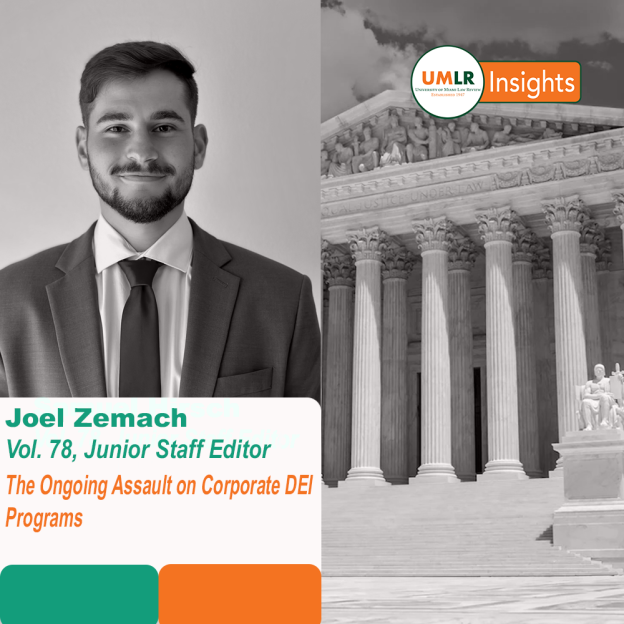JOEL ZEMACH—The Supreme Court’s decision to end universities’ affirmative action programs in Students for Fair Admissions, Inc. v. President & Fellows of Harvard College has sparked a flurry of litigation directed at extending the Court’s colorblind stance on education to corporate diversity, equity, and inclusion (“DEI”) programs. While the Court did not proclaim to effectuate changes to the laws governing private corporations’ hiring decisions, its ruling has emboldened those who believe that corporations’ efforts to improve the diversity of their workforces through DEI programs have done so in violation of the Fourteenth Amendment to the Constitution. Although corporate hiring practices should be altered to better align with the Court’s ruling and to better protect corporations from threats of future litigation, the Court’s decision does not prevent corporations from continuing to effectively engage in efforts to improve their workforce diversity.
The litigative efforts by groups opposing DEI programs in corporate hiring practices – including the American Alliance for Equal Rights (“AAER”), an organization created and spearheaded by affirmative action detractor Edward Blum – have already effectively altered DEI programs implemented at some of the world’s largest law firms without awaiting any formal court decision. According to Bloomberg Law, Perkins Coie and Morrison Foerster removed “race-based eligibility requirements” for their diversity fellowships in the face of “high-profile discrimination lawsuits” brought by the AAER. Further, the AAER’s website publicly states that it is “dedicated to challenging distinctions and preferences made on the basis of race and ethnicity,” and the organization is actively recruiting plaintiffs who believe that they have been wrongfully impacted by racially discriminatory policies.
In taking measures to protect themselves against the threat of litigation, then, corporations should consider “eliminating exclusionary parts of the hiring process.” According to one law professor at Rutgers University, “the most risky thing an employer can do is make any employment decision explicitly on the basis of race.” For instance, corporations currently offering diversity fellowship or scholarship programs that only permit individuals of particular racial backgrounds to apply would likely be viewed as engaging in risky conduct. However, corporations can still prioritize retaining a diverse workforce without prohibiting anyone from applying on the basis of race. In short, while corporations should open their applications to individuals of all racial backgrounds, they can consider, in the words of the Supreme Court, “how race affected the applicant’s life, so long as that discussion is concretely tied to a quality of character or unique ability that the particular applicant can contribute” to the workplace environment. As the Court acknowledges, by requiring applicants to submit essays describing how they previously “overcame racial discrimination” and how that experience “motivated him or her to assume a leadership role or attain a particular goal,” corporations can prioritize retaining employees with diverse racial backgrounds without exposing themselves to the threat of litigation.
The Court’s decision has arguably left room for employers to continue advancing DEI programs in the workplace in other ways as well. Notably, the New York State Bar Association (“NYSBA”), “the largest voluntary state bar association in the country,” recently issued a ninety-three page report offering strategies that would allow corporations to “continue to encourage diversity in a fashion that would stand up to legal scrutiny.” According to Richard Lewis, the president of the NYSBA, the report suggests that corporations should consider “pipeline programs, affinity or employee resource groups, fellowships, scholarships, mentorships, and sponsorships” to maintain a diverse workforce, since those programs have traditionally been considered lawful under Title VII. Additionally, corporations should “increase recruiting at institutions such as historically Black colleges and universities, Hispanic-serving institutions, and tribal colleges and universities,” and “shift to skills-based hiring” which “focuses on matching skills between job candidates and roles instead of focusing on only education and experience.” Lastly, corporations should consult with their attorneys to ensure that their hiring practices comply with existing law and to take preventative steps against potential legal threats. To that end, several law firms have launched task forces dedicated to addressing their clients’ DEI issues by performing “DEI assessments” that “effectively amount to an audit of a company’s diversity efforts.”
Ultimately, while the Court’s decision has created uncertainty surrounding corporate DEI programs and hiring practices, it has not made them illegal. Corporations can and should continue to advance DEI initiatives through alternative pathways, and several groups have already proposed varying solutions that avoid the pitfalls created by the Court. By establishing an environment that is conducive to diversity and inclusion, corporations can attract and retain top talent while maintaining a diverse workforce; however, they must avoid implementing DEI programs that explicitly exclude applicants on the basis of race alone.






